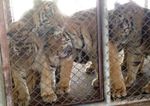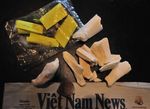Of tiger and lion bones and the legalizing of the rhino horn trade
←
→
Page content transcription
If your browser does not render page correctly, please read the page content below
Of tiger and lion bones and the legalizing of the rhino horn trade
© Campaign Against Canned Hunting
Value additions to lion bones sold into the Traditional Chinese Medicine Market:
Trophy hunter in SA books a lion ‘hunt’ of a captive born cat for approximately U$8000-25 000 (the cost
of hunting a female are a fraction of the cost of hunting a male).
The taxidermist, in collaboration with the hunting company arranges for the sale of the skeleton to a large
scale buyer in Laos for U$1500 per skeleton
The importer sells skeletons in bags to Vietnamese buyers for U$700-800 per kg ( a hundred kilo lion
would yield about 18 kgs of bone) or a sales price of about U$15000.
Vietnamese buyers from Ha Tinh province buy the lion bones by the ton and make down payments in the
hundred thousands of dollars
Bones are shipped across the Laos - Vietnam border with no CITES permits and in contravention of the
treaty
In Vietnam a 15 kg skeleton of a lion is mixed with approx. 6 kg’s of turtle shell, deer antler and monkey
bone is then boiled down in large pots over a three day period
This yields approx. 6-7 kg of tiger cake which is then cut into chocolate like bars of 100 grams resulting
into 60 or 70 portions which will be marketed as TIGER BONE CAKE.
Each bar will be sold at a price of around U$1000 to buyers who believe in the value of Traditional
Chinese Medicine and the myth associated with the consumption of “tiger cake” which in most cases is
consumed by being added to a glass of rice wine.
The skeleton of U$ 1500 will have been turned into a value added product (with the addition of bone
material from other species) of some U$ 60-70000.
At the CITES Conference of Parties (CoP16) in
Bangkok, earlier this year, I attended a press
conference where the South African Minister for the
Environment announced that South Africa had tried a
wide range of measures to curtail rhino poaching, but
she confirmed that so far they had failed and it was
now time to look at the option of legalizing the trade.
This proposal will result in a heated debate for months
or years to come. Discussions will be very polarized
with neither side willing to make compromises on
what they see as core principles.I have visited several ranches in South Africa and seeing happy, live rhinos enjoying what to me looked
like a good quality of life. It made for a pretty convincing argument that having a dehorned rhino grazing
with its calf is a better option than an orphaned calf trying to suckle on its slaughtered mother.
However, on my last trip to Laos and Vietnam, in
October this year, I once again investigated the
trade in tiger bone - another traditional Chinese
medicine (TCM) product in the same league as
rhino horn and I found a situation that might have
relevance when discussing the proposed legalizing
of the rhino horn trade.
In Thailand tourists paying to
interact with captive bred
tigers is a new fashion trend,
with many surplus cats
ending up being sold out the
back door.
First, a bit more background on the tiger bone/cake trade: a demand which is most pronounced in
Vietnam with tiger wine being the Chinese equivalent and with the penis being a key ingredient.
In 2010 a group of Vietnamese journalists managed to get into
one of the biggest tiger farms in Laos. They reported that a tiger
carcass was selling for U$ 140 a kg. The buyers, usually from
China or Vietnam, choose a live tiger and then pay per kg after
the cat has been shot or electrocuted. 7-10 kg is deducted from
the weight for the intestines. The price in 2010 per kg
was quoted a U$ 140 per kg for cats above 100 kg’s, a little less
for tigers below that. In October this year, a Swiss print
journalist and myself managed to get a Vietnamese investigator
to visit the same farm and film with a hidden camera. In 2010
the Vietnamese writers mentioned a stock of 100 tigers. Now the
farm has over 300, plus some bears and clouded leopards. The
farm is also being expanded to hold about 700 tigers. This will
be achieved with breeding and importing other captive borne
tigers, mostly from Thailand and Malaysia. Plus there are new
such farms being set up. All of this is illegal under CITES
resolution (14.69) passed in 2012 and stating:
Tiger cake - yours for U$1000
“Parties (to the convention) with intensive operations breeding tigers on a commercial scale
shall implement measures to restrict captive populations to a level supportive ONLY FOR
CONSERVING WILD TIGERS. Tigers should not be bred for their parts or derivate.”Overcrowding and other welfare issues are not a concern to the owners of tiger farms. Yet more cages being
constructed to increase the capacity of this farm from 300 tigers to 700.
There has never been a valid explanation how tiger
farming in any form will support the conservation of
wild tigers since they cannot be reintroduced into the
wild. Commercial captive breeding might be viewed
as having the potential to satisfy demand and bring
down prices of tiger parts and as such taking the
pressure of the wild populations, however that seems
not to be what is advocated with the above
notification.
As with other such international regulations, the
above is totally ignored in countries like Laos where
even national laws do not seem to apply to rich
foreign investors. The CITES enforcement regime
would allow a country like Laos to be suspended with
A frozen tiger cub offered to our investigator on
the Vietnamese side of the Vietnam/Laos border
all legal aspects of the trade having to stop, but that is a measure of last resort as far as CITES is
concerned. The policy seems to be to increase the number of member states irrespective of their ability
or willingness to comply with the convention.The breeding at this farm in Laos is clearly commercial, which appears to be legal in Laos. The cats are
pumped full of antibiotics with weekly injections due to previous outbreaks of epidemics which not only
killed a lot of tigers in many of the farms but in some cases also effected farm workers. The estimates
are that this farm alone sells several hundred tigers a year to be turned into TCM.
Lion bone being offered for sale by a key Laotian dealer, recorded on hidden camera
In addition to the numerous tiger farms across Asia,
increasing the supply far above what the poaching
of the remaining wild tiger population could ever
have produced, there are also the imports of lion
bones and skeletons from South Africa which are
sold as “tiger bone” to be turned into tiger wine
(China) or tiger bone cake (Vietnam). We are
talking of several hundred skeletons being exported
and imported on an annual basis and during our
investigations we were told of a 3 ton shipment
about to arrive. CITES trade statistics show the
export of 101 full lion skeletons from South Africa in
2010 and over 500 skeletons in 2011 (No figures
are available yet for 2012).
When comparing prices for full tiger carcasses
between Hanoi, the Laos and Vietnam border, and
the prices quoted by the journalists in 2010, the
‘per kg’ rate now averages out at U$ 200 - A 30%
increase since the Vietnamese media team visited
three years ago. This despite the drastic increase in
supply of both tiger and lion bone.
If we then put this in context with the estimate of
only 3000 tigers remaining in the wild and only a
handful left in a country like Laos, the message is
that prices are still going up, even more so for wild
tigers (A wild tiger can be identified by the colorand damage to its canines which are stained and chipped after a lifetime of hunting and catching wild
prey, while a captive tiger has snow white teeth with no cracks or breaks as they are fed on chickens).
The poacher today also gets more per kilo then he did three years ago and while it might still be a
fraction of the sales price of U$ 25000 per carcass, it is still more than enough incentive for qualified tiger
poachers to spread out from countries like Vietnam to far off destinations in Malaysia and Myanmar to
get their hands on some of the world’s last wild tigers.
Returning to the trade in rhino horn and the debate to legalize or not, the question arises -
would the same supply and demand scenario play out if the market was supplied with stocks
of legal rhino horn?
Confiscated rhino horn about to be burned in a show of defiance against poaching – currently an unused
resource in the fight against wildlife crime
Supposedly one of the main objectives of South Africa discussing the possibility of legalizing the rhino
horn trade is to flood the market with stores of rhino horn which will cause the price (currently U$ 60000
per kilo) to crash, decreasing the incentive for poachers.
This is the opposite of what we have found in our investigations into the trade in tiger and lion bones -
the additional supply from captive farming, and the introduction of imported lion skeletons - which now
exceeds by far the supply from the remaining wild tiger population - has not decreased the price, in fact
the price of tiger carcasses has increased drastically in the last three years.
There are many more tigers today in all of the countries involved in this industry than there used to be,
but they’re captive bred and living in small cramped cages waiting to be electrocuted at the request of a
Chinese or Vietnamese buyer.
Is this the way the world wants to see a
flagship species preserved?
Even today there is a high demand in Asia for tiger productsYou can also read



























































